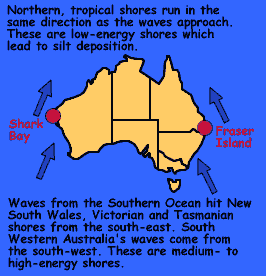|
|

Wind Effects
Environmental Factors
Deep ocean swells tend to be bigger and more powerful along southern shores. Strong daily winds create waves on top of that swell. Southern, south-eastern and south-western coastlines are continually barraged by waves as they come ashore.

In Northern Australia, wave-energy levels are dissipated by a number of geographic effects.

Australia bulges near Fraser Island in the east and Shark Bay in the west.
So northern shores run in the same direction as the southern waves approach.
Also, most of Queensland's coast is protected in an estuary-like situation sheltered behind the Great Barrier Reef.
References
Bennett, I. (1987) W. J. Dakin's classic study: Australian Seashores. p. 3-12, Angus & Robertson, Sydney.
Davey, K. (1998) A Photographic Guide to Seashore Life of Australia. p.8, New Holland, Sydney.
Environmental
Factors
Latitude
Currents
Wind Effects
Wave Strength
Tidal Effects
Desiccation
Substrate
Turbidity
Salinity
Home
Page
Taxonomy
Biogeography
Rocky Shores
Tidal Levels
Intertidal Zonation
Environmental Factors
Biological
Factors
Feeding Relationships
Activities
Glossary
References
 Life
on Australian Seashores
Life
on Australian Seashores
by Keith Davey (C) 2000
Learning Consultant
- Media
The University of Newcastle
email at australian_seashores@hotmail.com
Scientific Consultant: Phil
Colman
site created 01.01.98 : updated 01.04.2000